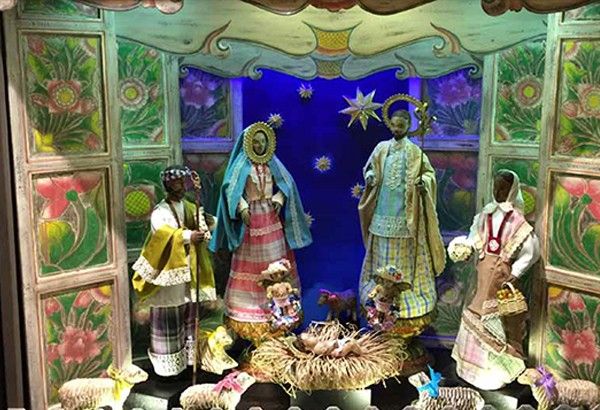Nativity in brown

The owner of the condo has a writing desk that is the mother of all writing desks. In front is a window with an eyeful of Ayala with its many variations of lines and color. On top of the desk is an aphorism about ideas. Also a toy piano, writing implements, as well as a painting by a Russian-French modernist master (who I shall not dare mention as the Marc Chagall…. but it’s done, so there). Many brilliant ideas have been birthed in that corner most probably. And in one of the rooms is a Belen. Yeah, it’s Christmas, New Year, and Feast of the Three Kings all-year round in this beautiful living space so conducive for inviting a swatch of epiphanies.
But it’s not an ordinary Nativity tableau with Mary, Joseph and the infant Jesus visited by adorers in Middle-Eastern garb. This one looks closer to home: Filipiniana charm, folksy roots and all.
Very folk, as Gino Gonzales would describe it: the figures of Mary and Joseph were carved in Bohol during the late 1800s to early 1900s, while the peasant figures are from mid-20th century. “When we first saw it on the countertop of Floy Quintos’ Gallery Deus antique shop, it had very ratty details made of sinamay and Abel Iloco. As Floy would say, ‘These are vestiges of the past.’ But it was very honest.” And rife with the symbolism of the humility of the birth of God.
Gonzales and Rafael del Casal were tasked by the homeowner in restoring and even reimagining this particular Belen.
Gino Gonzales is a renowned production designer. One of his landmark projects is the terno book titled Fashionable Filipinas: An Evolution of the Philippine National Dress in Photographs, 1860-1960 which he put together with Mark Lewis Higgins and was published by Ben Chan. Gino began his career under the tutelage of National Artist for Theater Design Salvador Bernal. Likewise, Gino’s partner in the Belen project also worked under Bernal. Rafael Del Casal is a master portraitist. Del Casal also creates baroque vestments for statues of saints and the Virgin Mary; has been in involved in Our Lady of La Naval commemorations; and was responsible for the iconic imagery of Pedro Calungsod and Lorenzo Ruiz.
“Floy told us that when we first got the Belen, the copa or base was all-brown,” explains Gino. “But they started cleaning it and all these beautiful colors came out. It’s very Bohol ‘yung ganyang folk coloring — from its churches to its urna or small folk altars. So, when we asked Rafael to redo the clothes, we respected the original state of the encarna or the painting on the wood. We didn’t want to alter it.”
Wooden staffs and other elements were tastefully retained but the clothes had to be redone, though. For inspiration, Del Casal looked toward an artist that was in the same milieu as this particular Belen.
“(The colors) were inspired by José Honorato Lozano watercolors,” Del Casal explains. “I used mostly cottons as well as laces that are a mixture of new and vintage — from an old lace handkerchief which I have.”
“Rafael bought so many fabrics (laughs) — from Crate & Barrel, etc.,” shares Gino.
Del Casal recalls asking Gino, “Shall we go light dark?”
And Gonzales answers, “Light… to go with the cabinet.”
The Belen, by the way, is encased in an ornate folk Chinese wooden cabinet bought from an antique dealer in Hong Kong and was originally purchased to be used as TV rack. It is patterned with flower carvings. A wooden angel hovers over the tableau. This makes for one curious matchup, I must say.
When creating the clothes, Del Casal remembered painting angels dressed in Filipiniana. Those works were also inspired by Lozano. And Lozano’s aesthetics are consistent with the time period where the Belen was possibly made.
“Just look at the silhouette of the skirt,” points out Del Casal. “That’s from the Lozano period. If we based our designs on Damian Domingo’s artworks, that would be of an earlier period, mas makipot ang bastidor.”
It took more than 10 people to put everything together, and — Gino and Rafael would laugh about this — it was finished just after New Year’s Day. Well, just in time for the feast day of the Magi. The homeowner gave them total creative freedom. Gino says that’s how she is as a cultural impresario: a woman who is drawn to the inspired and is herself inspiring.
Gonzales says that it’s a privilege for them to be able to work freely on this. “What’s important for us is for the Belen to look folksy and not too sophisticated or Westernized — unlike the Neapolitan crèche, which is finely detailed. We want to retain the charm of Filipino folk art. And it’s important for us to keep these folk traditions alive.”















